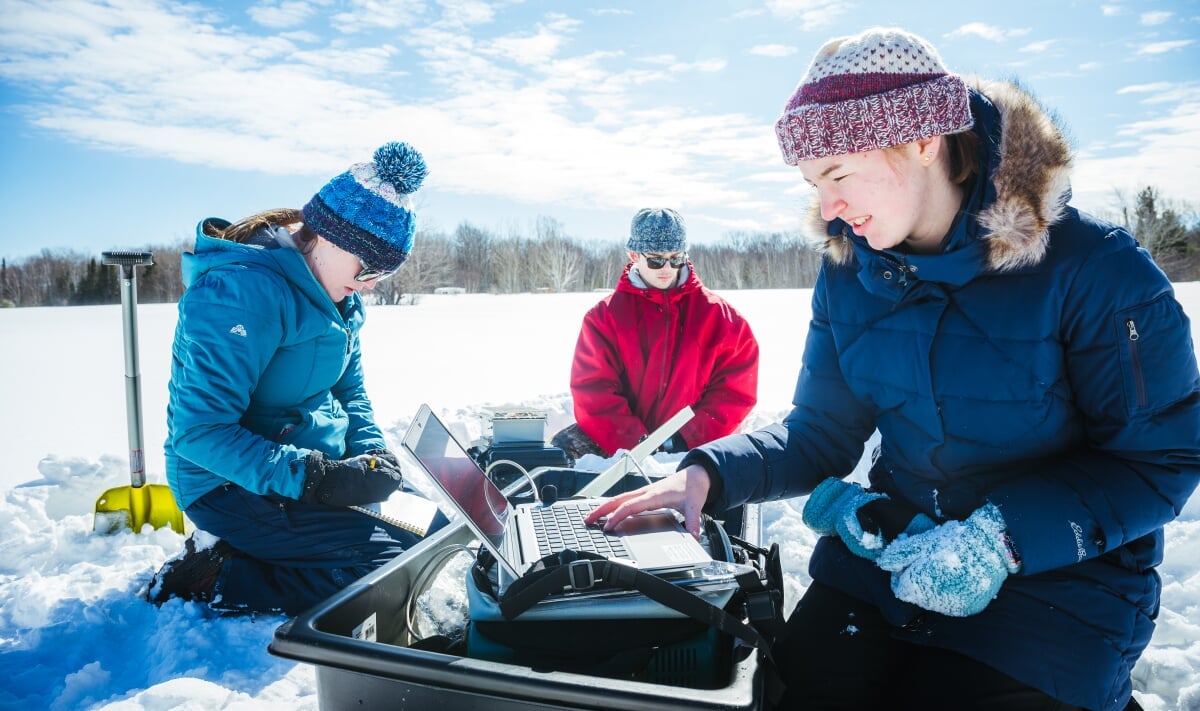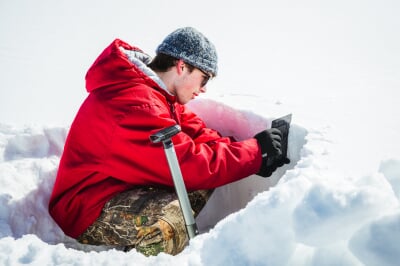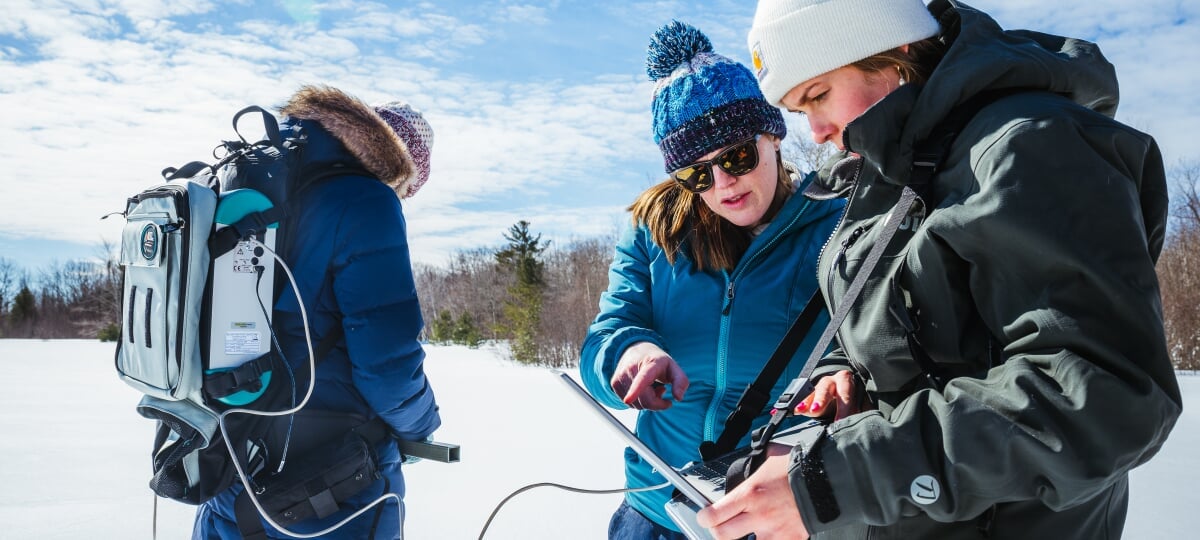At a field site just 15 minutes from Michigan Technological University's campus, Alden Adolph and her team of student researchers are studying the reflectivity of melting snow to better understand climate change on a global scale.
The Keweenaw Peninsula, home to Michigan Tech, has received over 250 inches of snow so far in winter 2024. Now, as spring arrives and the days become sunnier and warmer, the snow is melting. For Michigan Tech faculty member Alden Adolph, the process might hold the key to better understanding climate change and freshwater resource management.
Adolph, assistant professor of engineering fundamentals and mechanical engineering and aerospace, leads a new team of student researchers studying snow albedo, also known as sunlight reflectivity. More specifically, her team is studying the effect that liquid water from snowmelt or rain has on its albedo.
"All surfaces have an albedo," explained Adolph. "What's cool about snow is that it has a very high albedo, one of the highest albedos of natural surfaces on the Earth."
Its high albedo generally allows the snowpack to stay cooler by reflecting sunlight instead of absorbing it. There are many specific factors that can affect reflectivity, though, including snow grain size and the presence of impurities like dust or soot.

Adolph's team is looking at another variable.
"One aspect that hasn't been studied as much is how liquid water from snow that is actively melting affects albedo," said Adolph. "Often it's indirectly accounted for, so our work is looking fundamentally at how the presence of water in a snowpack affects its albedo."
But why study snow reflectivity? While for many, snow is simply a seasonal nuisance or a natural wonder, Adolph explains that snow albedo plays an important role in broader climate systems.
"Because snow is able to stay cool due to its high albedo, it has a global effect. By reflecting sunlight, the snow allows Earth to stay cool as well," she said.
A clear example of how snow protects Earth's climate can be seen in the Arctic Ocean, where snow and ice cover large portions of the water.
"As sea ice melts, it exposes more of the darker ocean water, which has a lower albedo and absorbs more solar energy, and heats up," said Adolph. "And that causes more ice to melt and then we are in a feedback loop." Understanding snowmelt and its effect on albedo can help keep those waters cool, which in turn regulates our planet against climate change.
There is also the potential to help local communities and their freshwater resource management. Adolph suggests her research could be used to better predict when snow will melt.
"In places like the mountainous west of the U.S. or in the Himalayas, they rely on snowmelt for their water, so figuring out when the snow is going to melt is important," said Adolph. "Studying snowmelt can be important for a local community as well as when considering a global response to climate change."
A Different Kind of Snow Day

The best way to study snow is out in the field. Adolph and her team of four undergraduate students have been routinely visiting their field site throughout the semester, taking measurements and collecting data on the snow's albedo, grain size and impurities, and the presence of liquid water.
Their field site, just north of Michigan Tech's campus near the Keweenaw Research Center, meets all of Adolph's requirements.
"The best snow field site is relatively open," she said. "We don't want trees around for a couple of reasons. Shading of the sun is one, especially here in the Houghton area where we have pretty low sun angles. We want to make sure we are able to get direct sunlight if possible."
Open fields also minimize the presence of debris like sticks and leaves, which affect albedo and also "muddy the waters" on the work Adolph and her team are trying to accomplish.
"And then it's important to be as level as possible," she said. "Different slopes of the surface affect how the sun comes in, which affects the snow's albedo."
Adolph and her team began their research in January by setting up a weather station at the site and taking initial measurements before the snow began to melt. The team continues to visit the field site a few times per week to take measurements as the snow melts — and continues to fall throughout March and into April.
"We usually spend about two hours making measurements, and we try to go out a few times a week, but especially on days when we know there will be extensive melt," said Adolph.

Following a particularly intense snowstorm in early March, the team pulled their specialized equipment to the site on a sled across almost 20 inches of fresh snow.
"It's also really interesting to be in a place with all this lake-effect snow and trying to think about how those dynamics could affect snow properties," said Adolph. "In a place with frequent snowfall, there's this idea of snow freshening, and I'm interested in how that affects snow albedo over time."
During their visit, the team went through their now-familiar routine. They started by taking notes of current weather conditions and measuring the snow's albedo using a backpack spectrometer to measure the incoming and reflected radiation, ranging from the visible spectrum to near infrared.
They dug snow pits all the way to the ground in order to measure snow depth, identify layers and measure snow grain size using custom instrumentation, as well as a standard hand lens. They used a snow fork to measure the liquid water content and density at many depths throughout the snowpack.
Some snow samples were collected to be brought back to their lab in the Great Lakes Research Center, where they'll be melted, filtered and analyzed for impurities.
The field site research is just the beginning. Adolph is currently advising a Senior Design team that is working on building an instrument that produces artificial snow of controlled grain size.
"That way, in the lab, we can create snowpacks of specific grain sizes and measure their albedo as it melts," she said.
Huskies Make the Best Snow Researchers
Adolph, who joined the College of Engineering in fall 2024, knows Michigan Tech is the place to study snow.
"I was so excited to be able to work here at Michigan Tech since Houghton is known as one of the snowiest places in the country," said Adolph.
But snow isn't the only abundant resource at Michigan Tech — students are known for their ingenuity and tenacity, another factor that drew Adolph to MTU.

"It's incredible that I came here specifically looking for undergraduate students to work with and there were so many students who wanted to be out in the snow," said Adolph. "They were excited to dig snow pits and ready with their snow gear. At Michigan Tech, you're working with students who are enthusiastic about snow."
Adolph's student team assists in all aspects of research.
"It's a lot of work," said Adolph, "but also a lot of fun."
The Huskies agree. Sam Hotchkiss, a second-year mechanical engineering student, says the field site visits are the highlight of his week.
"The work is more exciting than a standard class," said Hotchkiss. "Working on this project has been a step closer to the real world."
For Katie Wing, a junior in mechanical engineering, being involved in this research has given her a better understanding of climate science and broadened the possibilities for her future.
"Working with Adolph and the other undergraduate researchers has been eye-opening and fulfilling," said Wing. "This project has improved my MATLAB skills and shown me the many opportunities in environmental science, opening doors for my future."
Huskies use MATLAB software for data analysis, signal and image processing, control systems, wireless communications and robotics.
Cora Mullins, a first-year student in environmental engineering, considers this research an opportunity that can only be found at Michigan Tech.
"I feel like I'm getting to be a part of something that I wouldn't be a part of on another campus, especially as a first-year," said Mullins. "It's super cool to learn more about snow, which is something I've had to experience every year, yet I knew nothing about it. This has been a great experience and I can't wait to keep working on it in the future."
Michigan Technological University is an R1 public research university founded in 1885 in Houghton, and is home to nearly 7,500 students from more than 60 countries around the world. Consistently ranked among the best universities in the country for return on investment, Michigan's flagship technological university offers more than 120 undergraduate and graduate degree programs in science and technology, engineering, computing, forestry, business, health professions, humanities, mathematics, social sciences, and the arts. The rural campus is situated just miles from Lake Superior in Michigan's Upper Peninsula, offering year-round opportunities for outdoor adventure.






Comments